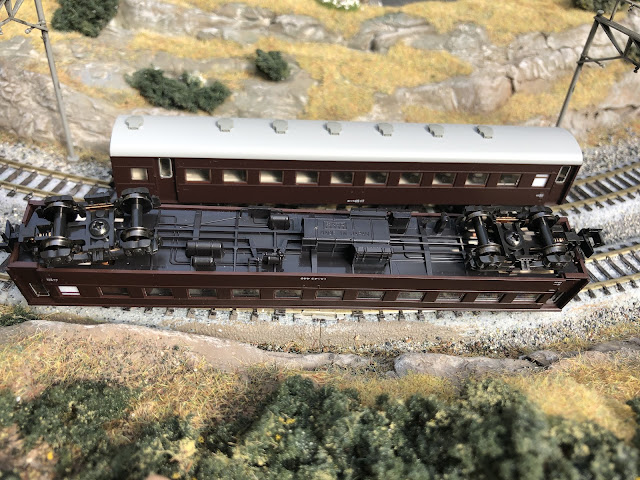Bit of a labour of love this one. While picked up inexpensively as a secondhand model, the sellers description that it 'ran' was only true in the loosest sense of the word. With only a single bogie working, and even that one growling and offering insufficient traction, the train just about crawled along, and needed occasional nudges to keep going. But after a few false starts, the model was fixed and now runs quite well.
Background
For me, this is an example of one of the most characteristic Japanese electric trains. Built between 1964 and 1979 across several different series, the type lasted in regular service until 2017. A few soldiered on on special services until 2022. They were intended to work on both AC and DC routes at up to 120 km/h, though the type could apparently reach speeds of up to 160 km/h safely.
The design was based on the earlier 151-series, and the earlier 485-series trains had similar front ends including the long, streamlined nose. From 1972 onwards, they were instead built with more flattened front ends that made it easier to couple two units together to form a single train. One distinctive feature of the type is the illuminated headboard panel at the nose, which in typical Japanese style has both the name of the train and some sort of colourful artistic flourish.
Inside, the trains were equipped to provide a comfortable environment in both hot and cold weather. The standard train comprised 11 cars including two first class cars and a dining car.
This particular model, however, is of a three-car variant as it operated between 2000 and 2011 on as the Kirishima & Hyuga limited express between Miyazaki and Kagoshima in the Miyazaki Prefecture on the southern tip of Kyushu.
Kato 10-913 485-Series 'Kirishima - Hyuga Type'
What's in the box?
- Two Kuha cab cars with working headlights, taillights, and illuminated headcode
- One powered Moha car with pantograph
The model didn't come with any extra parts. The instructions are printed on the back of the box. One cool feature though is that the illuminated headboard can be rotated using a very small flat-head screwdriver inserted into a small hole under the nose. The model can also be upgraded for internal lighting using the Kato 11-201 kits.
Although the model is equipped with headlights, taillights, and the backlit headboard, these are barely visible until the train is running at close to full speed. That's a bit disappointing since they add a lot of character to this sort of train.
Getting the thing running properly again!
As it came, the model barely ran and one of the couplings was broken.
Replacing the broken coupling, at least, was easy. A set of Kato 11-705 Type B Black Couplers was bought from TrainTrax and arrived within a couple of days. The broken one was pulled out, and after assembly, a new one pushed into the receptacle. So far, so good!
Getting the model running properly was more of a problem. One problem was a missing cardan shaft between the motor and one of the bogies. The motorised unit drives both bogies, and each bogie is connected to the motor via a green cardan shaft that has a similar sort of fitting at each end. The bogies pop out easily if pulled and twisted slightly, and presumably at some point in its life, the owner of this model had done that and lost one of the cardan shafts.
So, after rooting about the Kato website, I managed to find the cardan shafts used on the current 485-series models. I ordered a pack, and again, TrainTrax delivered them in a couple of days. But alas, they were not the right sort, as you can see in the picture above.
After a couple of emails to Kato, one of their engineers offered a solution! This particular model has been out of production for a while, and spare parts aren't available. But a different sort of bogie, ASSY #41912ZD1, would fit the model and had the right sort of cardan shaft. The engineer was absolutely right, and after receiving these from Kato, I popped them into the train and put it on the tracks. Off it went!
The story isn't over yet, though. While the motorised car now ran beautifully, the replacement bogies were designed for a different sort of train. The couplings were set back so far that it couldn't connect up to the two unpowered cars. Or rather, they'd connect on a straight, but as soon as the train hit a curve, it would derail.
With the couplings pulled out from their clip fitting, and then pushed in only a little bit, they could be glued to about the right length. Superglue did the job, and once dried, the bogies were put back into the train and tested. All went well!
While the bogies aren't the same colour as the originals, that can be easily fixed with some black paint. The main thing is that the model runs and brings a delightful splash of colour to the layout.
Conclusion
Operation is pretty good. Overall, the model runs smoothly, if not quite as quietly as the latest Kato trains. The motorised car seems to have no problems hauling the two unpowered cars. As mentioned above, the lighting is lacklustre, but otherwise this is an attractive train well worth the effort it took to get up and running.











